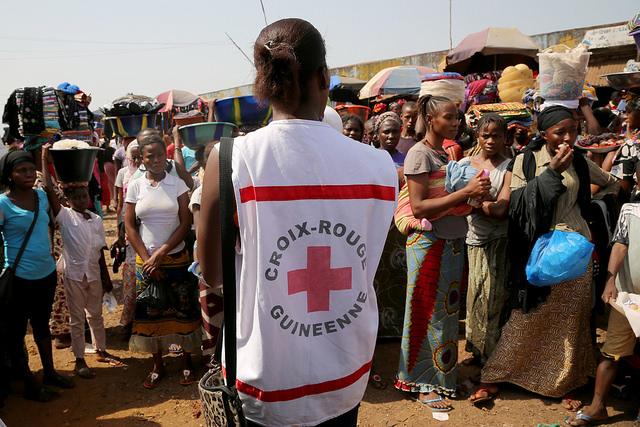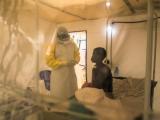The International Federation of Red Cross and Red Crescent Societies (IFRC) today sounded an alarm about ongoing attacks on its volunteers in Guinea, including an incident 4 days ago when two workers were beaten in Forecariah while trying to provide a safe and dignified burial.
In a statement today, the group said its volunteers in Guinea have been subject to about 10 attacks in Guinea each month since July, ranging from verbal to physical assaults.
Yesterday the World Health Organization (WHO) cited community resistance in Guinea, and to a lesser extent in Sierra Leone, as one of a handful of reasons why progress in reducing the case incidence in the outbreak region has stalled.
Violent incidents undermine Ebola safety
Youssouf Traore, president of the Red Cross Society of Guinea, said in the IFRC statement that Ebola-affected communities are put at greater risk when volunteers can't reach the populations and ensure that burials are conducted safely. "Red Cross volunteers are working day and night to keep communities safe," he said. "Acts of violence committed against them are completely unacceptable."
The IFRC said misconceptions and fear about Ebola are fueling the attacks, despite the fact that it has been working in Guinea since March to dispel rumors and myths about the disease, using radio and television. In consulting with religious leaders, families, and community members, the group said it has found dignified ways for people to pay their respect to the dead when Ebola is involved.
The IFRC and its affiliates called on humanitarian partners, governments, and the media to continue spreading messages about the disease and how people can protect themselves.
Traore said community engagement remains critical to battling the disease, and communities must understand the disease risks and how Red Cross volunteers are working to make people safer. "Now is not the time to be complacent, nor is it the time to pull out. Now is the time to push ahead, get down to zero, and stay there," he added.
Virus viability and drug experiment findings
In scientific developments with Ebola, researchers reported new findings about the stability of Ebola viruses in postmortem samples and described studies to flesh out two different treatment possibilities.
In the postmortem study, researchers from the National Institutes of Health (NIH) Rocky Mountain Laboratories in Montana studied macaques that died from Ebola to explore how stable the viruses were in tissues and body surfaces to help clarify the transmission potential and how detectable viral RNA is on corpses. Their goal was to help guide the best methods for determining if someone has died from Ebola and preventing the risk of transmission when handling dead bodies.
The team published its findings yesterday in Emerging Infectious Diseases (EID).
The investigators found that viral RNA was easily detectable from oral and blood swabs for 3 or less weeks on the carcass of a monkey who died from Ebola in environmental conditions similar to West Africa's outbreak setting. They found viable virus for at least 7 days after death in swab specimens and at least 3 days in tissues.
Investigators concluded that the Ebola reverse transcription polymerase chain reacation (RT-PCR) RNA target is very stable and that tissue sampling was no more effective than simple respiratory swabbing for diagnostic purposes, which may help determine if a victim died from Ebola and if contact tracing should be done. They also said the virus viability finding confirms that transmission from deceased people and wildlife can occur over an extended period after death.
In two other findings, researchers conducted a lab study to assess if an HIV drug shows any hint of usefulness against the virus, and another group delved into the ability of phosphorodiamidate morpholino oligomers (PMOs) to target the RNA of Ebola virus proteins.
In the first study, also in EID yesterday, researchers from an NIH lab in Frederick, Md., looked at the action of the HIV drug lamivudine in Ebola-infected monkey and human cells. In September, a Liberian doctor had reported promising findings after using the drug in 13 of 15 patients, though clinical confirmation of Ebola infection in the patients has not been verified.
The new experiments didn't find any evidence that the drug directly inhibits Ebola RNA polymerase or virus replication. However, the team said systemic and off-target effects might be possible, and they plan to assess lamivudine in a mouse model.
In the PMO study, a research team led by the US Army Medical Research Institute of Infectious Diseases (USAMRIID) conducted a follow-up on findings that PMOs targeting two different Ebola proteins—VP35 and VP24—protected rhesus monkeys from fatal Ebola infection.
In a Feb 10 report in mBio, the team wrote that a PMO-plus compound targeting only VP24 was enough to protect against lethal Ebola infection, but one that targeted only VP35 offered no protection. They concluded that the finding adds to evidence that VP24 is a promising target for Ebola drug development.
Other developments
- Dallas-area health officials in Morbidity and Mortality Weekly Report (MMWR) today described some of the lessons they learned during contact monitoring in connection to a Liberian man who got sick and died from Ebola after he arrived in Dallas and two health workers who got sick after caring for him. In connection with the cases, they and the US Centers for Disease Control and Prevention (CDC) monitored 179 close contacts, including 149 healthcare workers, 20 community contacts, and 10 people who were transported in an ambulance that had carried the Liberian man. They found that the people needed more than just temperature and symptom checks. Contacts reported social isolation and stigma and turned to their contact tracers for support. To varying degrees they also needed material support, such as rent assistance, food, diapers, and medical supplies. Some were school-age children who needed school supplies so they could keep up with schoolwork. Some of the contacts were part of the local Liberian community, and the contact tracing team was able to work with organizations to provide aid in a culturally sensitive manner.
- In a separate MMWR report today, CDC experts and their Nigerian partners described the lessons learned from the July group quarantine of five people in Lagos who had high-risk exposure to that country's Ebola index patient, a man who was sick upon arriving from Liberia. Though they wrote that group quarantine isn't standard practice, the five people subjected to the measure lived in crowded homes or had occupations that would have resulted in widespread exposure if they had become sick with Ebola. The group was kept in an isolation ward that consisted of eight beds in one large room with four separate bathrooms, with access to a living area that had a television and kitchen. Visitors were restricted to the unit's front porch. The researchers said none got sick during the quarantine and though not ideal, it allowed them to stay in the community and might have helped with disease-control efforts.
- In its latest report on Ebola numbers, the WHO said today that the number of confirmed, probable, and suspected Ebola cases in West Africa has grown to 22,903 and that the number of deaths has reached 9,194. The data include cases reported as of Feb 9 in Guinea and Sierra Leona and Feb 7 in Liberia. Today's numbers reflect an increase of 44 cases and 32 deaths over yesterday's totals.
See also:
Feb 12 IFRC statement
Feb 11 EID study on Ebola virus postmortem stability
Feb 11 EID study on lamivudine on Ebola virus replication
Feb 10 mBio study
Feb 13 MMWR report on Texas Ebola contact monitoring
Feb 13 MMWR report on group quarantine in Nigeria
Feb 12 WHO update


















